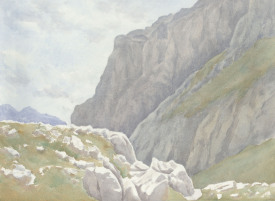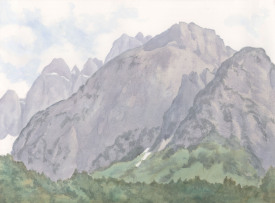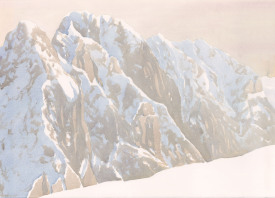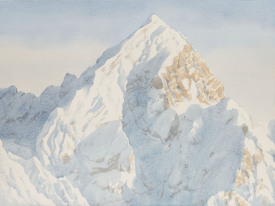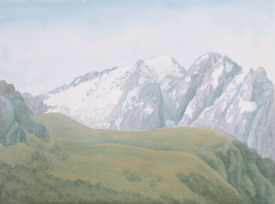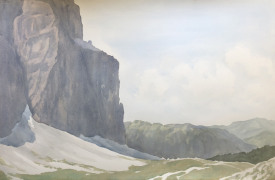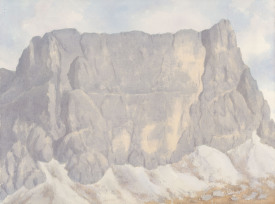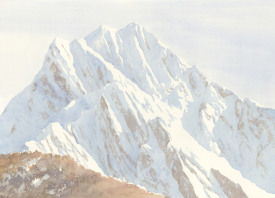Riccarda de Eccher
by Bryan Granger
When one leaves the place where she grew up—the place that shaped her as a person—how does such a place remain with her when she is no longer there? Riccarda de Eccher, now living a long way from the northern Italian Alps that played a formative role in her upbringing, turned to representational form to explore the landscapes of her home. Given that de Eccher grew up near the raw rock formations that give the Dolomites their striking beauty, it is no wonder she became an avid hiker and mountaineer. This passion stuck with her, and she went on to climb many of the world’s most prominent ascents, including Mount Everest in the 1980s.
After moving to New York City, the artist’s hiking journeys dwindled as she traversed city blocks instead of mountain passes. But during the hikes she did embark on, she began to be interested more and more in the small details she encountered, such as flowers, plants, and interesting rock formations. In an effort to understand these elements better, she would bring a sketchbook, pencils, and watercolors, and she would document them in a visual form. In this way, her studying of the minutia on a trek helped her relate to the larger landscape. By committing them to her sketchbook, she began creating physical forms for the memories she accrued from these adventures.
As de Eccher drew many of the small details she saw around her in these landscapes, her understanding of mountains as a whole became clearer. Soon she was capturing entire mountain peaks in her sketchbooks. Meditations on individual flowers shifted into ethereal mountain scapes. For de Eccher, this shift signifies the importance of all the constituent parts of landscape—for her, there is no mountain without the flourishing plants and scattered pebbles she encounters on the way up the slope.
The artist’s efforts to document the mountains that shaped her evolved into her work of the last several years, characterized by ethereal representations of mountain peaks. Initially, many of the images focused on the craggy rock formations themselves—often with their fabled Alpine snow. These early mountain peaks, as seen in Pelmo (2014) and Spalti di Toro (2015), are somewhat divorced from the ground. Her composition in works like these is attuned to the peaks, not to the greater landscapes to which they belong. As with her earlier focus on details, here she presents merely another small part of the mountain scape as a whole. Furthermore, without any grounding, her majestic mountain peaks float in space, bringing a paradoxical lightness to the subject matter.
In more recent works, however, de Eccher’s images have become grounded, and she has started to frame the peaks within the context of their landscapes. Her Nabois and Val Lasties (both 2018) illustrate this quite well: craggy rock formations in the background are juxtaposed with greener landscapes in the foreground. In Val Lasties, a valley that appears in two of her works included here, the mountain itself is cropped on the left side of the picture, bringing viewers’ attention instead to the sprawling valley and the distant Alps beyond. There are no mountain peaks without the valleys in between.
This change in scope is particularly evident in de Eccher’s treatment of Marmolada, the tallest of the Dolomites. In a 2015 rendering—which was featured in her 2017 exhibition Montagna at the Halsey Institute—she explores the characteristic rock and snow formations on the top of the mountain. In a 2020 version of the same mountain, her scope is much wider, portraying the same craggy formations from a distance. In the foreground, a lush, green valley frames the mountain, drawing viewers’ eyes to the landscape as a whole. Here, the artist presents the Marmolada in context—it is no longer an idealized mountain peak but now a majestic rock formation that belongs to a particular landscape.
Her works are not documentary—she often shifts details and rearranges certain elements of these mountain scapes. In doing so, though, she presents them in somewhat idealized forms, forms that better align with her memory and past experience. In representing these landscapes—partially motivated by a desire to explore them from afar—it is significant that she renders them with paint and watercolor rather than making photographs. As these landscapes were ones that helped shape her early years and ones that live on in her memory, her choice of media reinforces the weight of her memories here. Whereas a photograph captures a somewhat objective view of a mountain from a specific moment in time, her paintings reveal the totality of her explorations, memories, and sentiments towards these formative landscapes.
Riccarda de Eccher
Born in Bolzano, Italy (1954)
Lives and works in Long Island, New York
Riccarda de Eccher grew up in Udine, Italy. She began painting primarily watercolors later in her life. Her love of mountains, particularly the northern Italian Alps of her homeland, has made them the subject of her work. de Eccher is a seasoned mountaineer who has scaled many of the summits depicted in her work and beyond, including Mount Everest.
de Eccher’s work has been featured at the Casa Cavazzini Museo d’Arte Moderna e Contemporanea, Udine, Italy; Galleria d’Arte Moderna Enrico de Cillia, Treppo Carnico, Italy; Gallery ArtCube, Paris, France; and the Sala delle Esposizioni, Bolzano, Italy, among others. She has also published several books of short stories featuring her paintings.
Riccarda de Eccher’s work was featured at the Halsey Institute in 2017 in Montagna.
Bryan Granger
Bryan Granger is currently the Director of Exhibitions and Public Programs at the Halsey Institute of Contemporary Art at the College of Charleston School of the Arts. Granger earned his MA in Art History from Hunter College in New York City. He has helped to organize exhibitions on artists such as Boehler & Orendt, Jennifer Wen Ma, Katrina Andry, Peter Eudenbach, Sara Angelucci, Tom Stanley, Marc Trujillo, Aurora Robson, Chris Jordan, and Colin Quashie and others. He has helped produce and write for catalogues on artists Marc Trujillo and Fahamu Pecou. He also served as Knight Curatorial Fellow at the Bass Museum of Art in Miami Beach, where he helped to organize exhibitions on artists such as Piotr Uklański, El Anatsui, Eve Sussman + Rufus Corporation, among others. He also has curatorial experience with the Museum of Contemporary Art in Chicago, where he assisted with research and the organization of Form, Balance, Joy: Alexander Calder and Contemporary Art, for which he also contributed to the catalogue. He also has experience with the organizations Independent Curators International, the Artist’s Institute, and Minus Space, all in NYC. His writings have appeared in DAILY SERVING and Art Practical.

